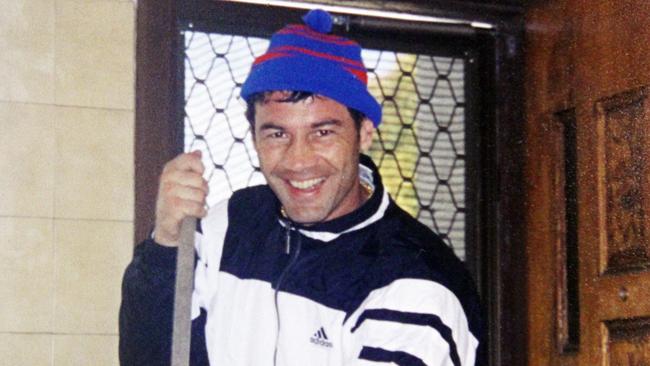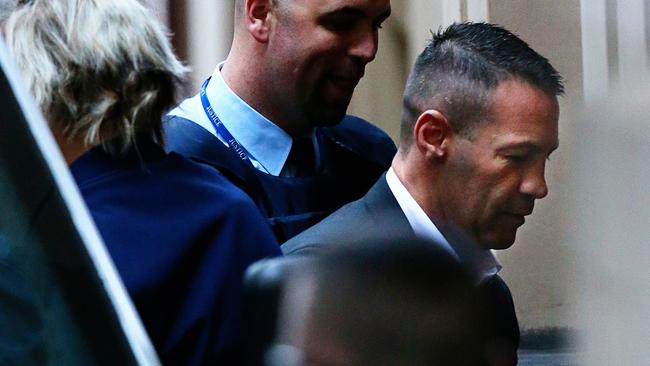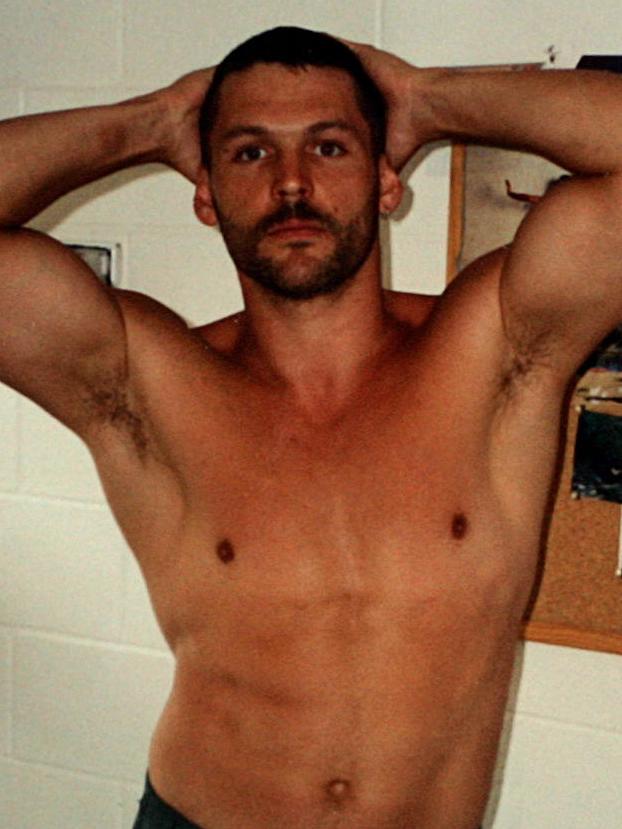Andrew Rule: Was underworld figure Evangelos Goussis a casualty of Snake Eyes?
Underworld figure Evangelos Goussis was convicted of the murders of Lewis Caine and Lewis Moran, but was he a heartless hitman or just a gullible goose?

Andrew Rule
Don't miss out on the headlines from Andrew Rule. Followed categories will be added to My News.
It’s a scene that could be straight from Mr Inbetween, the best Australian crime drama since Blue Murder, Chopper and Underbelly.
It happens in a spot Melbourne people know well.
It’s around midnight and the inner-suburban pubs and restaurants are emptying. Police have put a breathalyser van at a favourite choke point — along the nowhere-to-hide road that curves through Royal Park past the zoo, at this time of night mostly funnelling traffic from the north and east towards west and south.
The flashing lights and coloured wands waved by bored constables are a nuisance for the law-abiding, and scary for drivers who’ve had a couple of drinks.
But for two gunmen in a black SUV, it could be a very big deal, indeed.
Because if any of the bored police wave a torch over the vehicle, they will see that the back window is shattered — shot out, in fact, according to a senior legal figure close to the case. Closer inspection would show fresh blood spattered inside.
The reason? The passenger, one of the most notorious criminals in the land, has just shot a third man, who unwisely accepted a lift with his drinking “mates” from a Carlton pub.
The driver is Evangelos “Goose” Goussis, the former boxer whose career took a wrong turn a long way back.
“Goose” had the guts but missed the glory — instead of Olympic medals and a picket fence in the suburbs he’s gone to the dark side, a grand-in-the-hand minder for bad guys.
Goussis had only a few professional fights under Queensberry Rules but as a hot kickboxer he took a young Sam Soliman to a split points decision in 1994, and no easy beat does that.
Soliman became a champion in both codes, but that night Goussis matched him, which tells you something about his grit.
Sadly, he was as gullible as he was game, and fell for gangsters’ poisoned promises.
Ten years later, as a “minder”, Goussis isn’t looking after some Arfer Daley rogue selling Taiwanese Scotch and fake Rolexes. He’s collecting drug debts with an older man, one of the most devious reptiles in the underworld snake pit. So now we call him Snake Eyes, not the name his second-generation criminal parents gave him.
Snake Eyes is the man in the passenger seat, still in possession of the pistol he’s just used to shoot a handsome young killer known mostly as Lewis Caine.
Caine, alias Sean Vincent, achieved a notoriety in death that he would have relished in life as a wannabe gangster known more for his romance with solicitor Zarah Garde-Wilson.
As the black car slows for the breathalyser, if a police torch plays across the shattered rear window, the game’s up. But a cop waves the killers’ car past the queue and it quietly vanishes into the darkness.
Three days later, the Herald Sun’s crime reporter Mark Buttler is ringing around for background on Caine, 27th and latest victim in the gangland war. Buttler has Snake Eyes’ number and calls it, a routine chore in the news business.
The old reptile answers the call. Buttler notices that he pauses a beat and takes a breath before answering his questions as smoothly as any professional liar.
Snake Eyes says that by chance he “bumped into” this Caine fella recently. Seemed “a nice bloke”, he volunteers, although his real opinion might have surfaced in his next line: “I don’t think he was a gangster or a big-timer — he might have been trying to be.”
It is an Academy Award performance from a man who must suspect he is, as usual, one of the usual suspects.

Naturally, Buttler takes his cheerful answers at face value. It gives him some handy quotes a week later, on May 19, 2004, when special operations cops grab the devious old gunman with Goussis at a Geelong shopping centre.
Caine had been predicting his own murder for weeks, if not months, although he boasted he would try to get in first. Unfortunately, his crystal ball didn’t tell which “friends” in the underworld would turn on him.
For Goussis, that treachery should be a warning. But he stubbornly sticks with first one, then another, preposterous fabrication that Snake Eyes cooks up, even though both versions shift blame from the Snake to the Goose.
Goussis’s blind loyalty makes him a mug — but never an informer, which is what his old reptile mate turns out to be: a supergrass, one of the hated handful in the “Deal Or No Deal” crew inside.
Every snake has his price and this one sells out to the police and so the courts grant him lifetime anonymity as an informer, which is why we are calling him names.
In the end, Goussis the gullible keeps his mouth shut and is convicted not just for Caine’s murder, but for the shooting of Lewis Moran in the Brunswick Club the previous year. He is handed a stonking 35-year sentence.
There’s a fair argument Goussis was not in the Brunswick Club for the Moran shooting and that he was driving when the other man cold-bloodedly executed the half-drunk Caine.
That hardly makes Goussis an innocent bystander in what was most likely a premeditated hit. He had, after all, once been jailed for cleaning up after the murder of a drug dealer.
But everything is relative. Compared with another leading kickboxer who was an active criminal through the same era, Goussis is a choir boy.
The other martial artist who took up gunplay is Pasquale Lanciana, who fought under the name Percy “No Mercy”. Percy is one of a tight group of kickboxers who get their kicks on the dark side.
Lanciana has dodged detection and conviction for decades but his luck ran out this week, when he was finally convicted (in a retrial) for his part in the Richmond cash van heist that rivals the Great Bookie Robbery of 1977 for brilliant planning and sheer bravura.
The big difference between the Richmond heist of 1994 and the bookie robbery is that the Richmond crew clean got away with it — that is, until Lanciana hit trouble years later when using other people to exchange stolen cash.
The heist is straight from Hollywood. A gang member has mapped the armoured van’s weekly routine: picking up cash in the city then going around the MCG to Punt Rd and south towards the river before turning left onto what is now the Monash Freeway.
On June 22, 1994, in the shadow of the freeway under the Nylex clock, the robbers pose as a road repair crew, complete with work clothes, hard hats, protective glasses, a concrete-cutting saw — and, crucially, a lollipop stop sign to halt traffic.
One plotter sits near the MCG in a small tradies’ truck. He pulls in behind the van and follows it until the “road crew” halt it. The truck is vital to the plan because it is just big enough to block the view of motorists stuck behind.
A “road worker” starts the concrete saw, which throws up dust and ear splitting noise and is perfect cover for what happens next: the gang produces a key that opens the rear door of the cash van, where they surprise the guards inside.


That key represents insider knowledge at the heart of the heist. To this day the source has never been revealed, although there are rumours of a locksmith with crime connections.
In minutes, the robbers escape with a figure most often put at $2.32m. There are rumours about who is behind it but, for more than 20 years, no arrests.
In the highly unlikely event that Lanciana ever talks, he might nominate some interesting associates. Among them, perhaps, two men named in his retrial as suspected members of the Richmond robbers: some time helicopter pilot Wladimir “James” Babaeff and gymnasium proprietor and instructor Paul “The General” Fyfield.
Neither Fyfield nor Babaeff was charged over the Richmond robbery. Babaeff was acquitted in 2017 of a $500,000 robbery of Myer’s city store in 1993 and Fyfield was found not guilty of theft of $1.1m cash from a mysteriously-unattended armoured car in Sunshine in 2006.
Others suspected of being in the crew include two, or maybe three, brothers who guard their privacy keenly, mostly with savage dogs. At one country property, the dogs are tethered at close intervals around the house yard so no-one can sneak up.
Lanciana has not been sentenced yet but, at 63, he faces long years in jail. If he ever gets out, he will be very old and probably less dangerous. That could encourage people to consider the big rewards on offer for at least two unsolved murders of young women.
One is Lanciana’s 25-year-old wife, Maryanna, shot dead in bed at their Werribee home in July, 1984. There was no sign of a struggle or forced entry.
Lanciana’s alibi is that he was working at his pizza parlour in Chapel St, Prahran, then doing a late shift on the door of a city nightclub before sleeping at his parent’s Seddon house because he was too tired to drive home to Werribee.
Another young mother was shot dead while asleep at her brother’s home in the St Albans-Sunshine area in September 1981. Her name was Antje Jones and she was back in Melbourne briefly after divorcing her husband, a garage owner named Clifford Jones.
An agile and pitiless gunman climbed over a back fence, quietly forced the back door and shot Antje in the head with a high calibre handgun.
Strangely, the then head of the Melbourne crime department, the late Phil “Fat Harry” Bennett, declared in a press conference that this brazen execution looked like “a burglary gone wrong”.
That attitude helped stall the investigation for decades, until a $1m reward was announced in 2019 after a former homicide detective told a reporter the Antje Jones case was a stinker. When some fresh information was given to homicide, a $1m reward was posted over the Antje Jones murder — matching the reward put up for the Maryanna Lanciana killing five years earlier.
Those two are not the only unsolved cases that detectives suspect might be linked to the kickboxing scene.
When a young but already restless Ange Goussis fought a future world champion back in 1994, each had a respected corner man.
The rival’s corner man was a fearless and admired trainer who has been shot a few times and never said much about it.
And in the Goussis corner? One of Lanciana’s closest mates.
It’s a small world.





